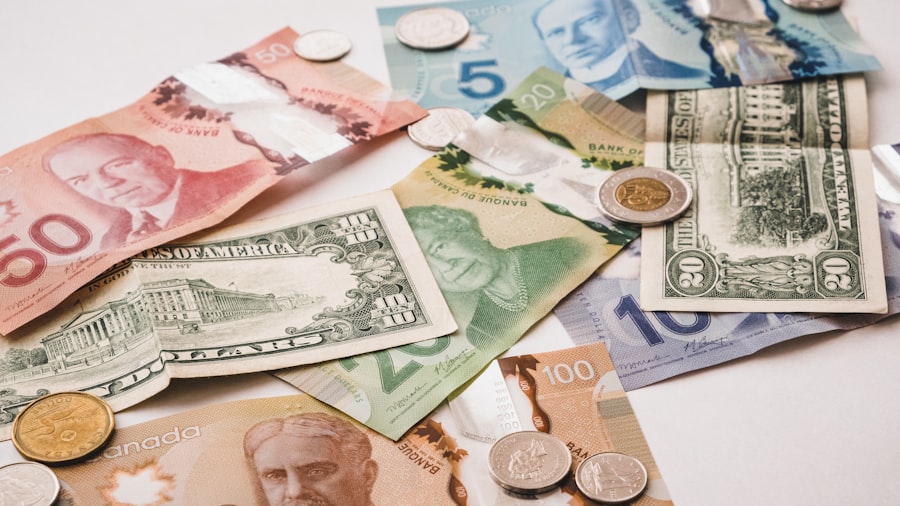As you navigate the complex landscape of finance, the looming threat of a dollar crash may weigh heavily on your mind. The dollar, as the world’s primary reserve currency, plays a pivotal role in global trade and investment. However, economic fluctuations, geopolitical tensions, and shifts in monetary policy can create an environment ripe for a significant decline in the dollar’s value.
Understanding the implications of such a crash is crucial for anyone looking to safeguard their financial future. The potential for a dollar crash can evoke feelings of uncertainty and anxiety. You may wonder how such an event could impact your investments, savings, and overall financial stability.
As the dollar weakens, purchasing power diminishes, leading to higher prices for goods and services. This scenario can create a ripple effect throughout the economy, affecting everything from consumer spending to business investments. By exploring various investment strategies and asset classes, you can better prepare yourself for the challenges that may arise in the event of a dollar crash.
Key Takeaways
- The dollar crash is a significant event that can impact various investment options.
- Real estate investments can be a safe haven during a dollar crash due to their tangible nature and potential for long-term growth.
- Luxury goods and collectibles can be a good investment during a dollar crash as they tend to hold their value and may even appreciate.
- High-risk stocks and cryptocurrencies can be volatile during a dollar crash, but they also have the potential for high returns.
- Cash and savings accounts may lose value during a dollar crash due to inflation, making them less attractive as investment options.
Real Estate Investments
When considering how to protect your wealth during a potential dollar crash, real estate investments often emerge as a viable option. Real estate has historically been viewed as a stable asset class that tends to appreciate over time, even in turbulent economic conditions.
Investing in real estate allows you to diversify your portfolio while providing a potential source of passive income through rental properties. In times of economic uncertainty, demand for housing often remains resilient, as people always need a place to live. By acquiring properties in desirable locations or investing in rental units, you can create a steady cash flow that may help offset losses incurred from other investments during a dollar crash.
Additionally, real estate can provide tax advantages and long-term appreciation, making it an attractive option for those looking to secure their financial future.
Luxury Goods and Collectibles

In the face of a dollar crash, luxury goods and collectibles can serve as alternative investments that may retain or even increase their value. High-end items such as fine art, rare coins, vintage wines, and luxury watches often appeal to affluent buyers who are less affected by economic downturns. As you consider diversifying your investment portfolio, exploring the world of luxury goods can be an intriguing avenue to pursue.
Collectibles often possess intrinsic value that transcends currency fluctuations. For instance, art pieces from renowned artists or limited-edition collectibles can appreciate significantly over time, making them attractive assets during periods of economic instability. As you delve into this market, it’s essential to conduct thorough research and seek expert advice to ensure that your investments are sound.
By investing in luxury goods and collectibles, you may not only enjoy the aesthetic pleasure they provide but also create a financial buffer against the potential fallout from a dollar crash.
High-risk Stocks and Cryptocurrencies
| Asset | Risk Level | Volatility | Market Cap |
|---|---|---|---|
| Stock A | High | 10% | 500M |
| Stock B | High | 12% | 300M |
| Cryptocurrency X | High | 15% | 1B |
| Cryptocurrency Y | High | 18% | 800M |
While high-risk stocks and cryptocurrencies may seem like a gamble during uncertain economic times, they can also present unique opportunities for growth. As you consider your investment strategy in light of a potential dollar crash, you might find that these volatile assets offer the potential for substantial returns. However, it’s crucial to approach these investments with caution and a well-thought-out plan.
High-risk stocks often belong to emerging companies or industries that have yet to establish themselves in the market. Investing in these stocks can yield significant rewards if you choose wisely; however, they also come with the risk of substantial losses. Similarly, cryptocurrencies have gained popularity as alternative investments that operate outside traditional financial systems.
While they can be highly volatile, many investors view them as a hedge against inflation and currency devaluation. As you explore these options, ensure that you stay informed about market trends and developments to make educated decisions.
Cash and Savings Accounts
In times of economic uncertainty, maintaining liquidity through cash and savings accounts is essential. While it may seem counterintuitive to hold cash during a potential dollar crash—when its value is expected to decline—having readily accessible funds can provide you with flexibility and security. You may find that cash reserves allow you to seize investment opportunities that arise during turbulent times or cover unexpected expenses without resorting to high-interest debt.
However, it’s important to recognize that cash holdings may lose purchasing power due to inflation during a dollar crash. To mitigate this risk, consider diversifying your cash holdings across various accounts or financial institutions. High-yield savings accounts or money market accounts can offer better interest rates than traditional savings accounts, helping your cash grow at a pace that keeps up with inflation.
By maintaining a balance between liquidity and growth potential, you can navigate the challenges posed by a dollar crash more effectively.
Risky Business Ventures

If you’re feeling particularly adventurous in your investment approach, exploring risky business ventures could be an option worth considering during a dollar crash. While these ventures come with inherent risks, they also have the potential for high rewards if executed successfully. You might find opportunities in startups or innovative projects that align with emerging trends or technologies.
Investing in risky business ventures requires thorough research and due diligence. You should assess the market demand for the product or service being offered and evaluate the management team’s experience and track record. By carefully selecting ventures with strong growth potential and sound business models, you can position yourself to benefit from their success while navigating the uncertainties of a dollar crash.
High-interest Debt
While it may seem counterproductive to consider high-interest debt during uncertain economic times, understanding its implications is crucial for your financial strategy. High-interest debt can become particularly burdensome during a dollar crash when inflation rises and purchasing power declines. If you currently carry high-interest debt, it’s essential to prioritize paying it down before investing in other asset classes.
In times of economic instability, interest rates may rise as lenders become more cautious about extending credit. This scenario can exacerbate the challenges posed by high-interest debt, making it even more critical for you to develop a plan for repayment. By focusing on reducing your debt load now, you can free up resources for investments that may provide better returns during a dollar crash.
Inflation-prone Bonds
Bonds are often considered safer investments compared to stocks; however, not all bonds are created equal—especially during periods of inflation or currency devaluation. Inflation-prone bonds can be particularly vulnerable during a dollar crash as their fixed interest payments may lose value over time. As you evaluate your bond investments, it’s essential to consider how they will perform in an inflationary environment.
To protect yourself from potential losses associated with inflation-prone bonds, consider diversifying your bond portfolio by including inflation-protected securities or floating-rate bonds. These types of bonds are designed to adjust their interest payments based on inflation rates or market conditions, providing you with some level of protection against currency devaluation. By being proactive in managing your bond investments, you can better navigate the challenges posed by a dollar crash.
Overvalued Commodities
As you assess your investment strategy in light of a potential dollar crash, it’s essential to be cautious about overvalued commodities. Commodities such as gold, oil, and agricultural products often attract investors seeking safe havens during economic uncertainty; however, overvaluation can lead to significant losses if prices correct sharply. Understanding market dynamics and supply-demand factors is crucial when investing in commodities.
To mitigate risks associated with overvalued commodities, consider diversifying your commodity investments across various sectors or asset classes. This approach allows you to spread risk while still benefiting from potential price appreciation in undervalued commodities. Additionally, staying informed about global economic trends and geopolitical developments can help you make more informed decisions regarding commodity investments during uncertain times.
Risky Derivatives and Options
Derivatives and options trading can be enticing for investors seeking high returns; however, they also come with significant risks—especially during periods of economic instability like a dollar crash. These financial instruments derive their value from underlying assets and can lead to substantial losses if not managed properly. As you explore this avenue of investing, it’s crucial to understand the complexities involved.
Engaging in derivatives trading requires a solid grasp of market mechanics and risk management strategies.
By educating yourself on these instruments and developing a disciplined approach to trading, you can navigate the risks associated with derivatives while potentially capitalizing on market volatility during a dollar crash.
Conclusion and Recommendations
In conclusion, preparing for a potential dollar crash requires careful consideration of various investment strategies and asset classes. By diversifying your portfolio across real estate, luxury goods, high-risk stocks, cash reserves, and other alternatives, you can create a robust financial strategy that mitigates risks associated with currency devaluation. As you navigate this uncertain landscape, it’s essential to stay informed about market trends and economic developments while remaining adaptable in your investment approach.
Regularly reassessing your portfolio will allow you to make necessary adjustments based on changing conditions. Ultimately, by taking proactive steps now to protect your wealth and diversify your investments, you can position yourself for success even in the face of potential economic turmoil caused by a dollar crash.
In the context of preparing for a potential dollar crash, it’s crucial to understand which assets might be the most vulnerable. An insightful article that delves into this topic can be found on Real Lore and Order. This piece discusses various asset classes and their potential risks in the event of a significant devaluation of the dollar. For a deeper understanding of the worst assets to own before a dollar crash, you can read more about it here. This article provides valuable insights into financial strategies and asset management during economic uncertainties.
WATCH THIS! The 8 Assets You OWN But the Government CONTROLS (Dollar Collapse Survival)
FAQs
What are the worst assets to own before a dollar crash?
Some of the worst assets to own before a dollar crash include cash, long-term bonds, and assets denominated in US dollars.
Why is cash considered a bad asset to own before a dollar crash?
Cash is considered a bad asset to own before a dollar crash because its value can be eroded by inflation, and in the event of a dollar crash, the purchasing power of cash may significantly decrease.
Why are long-term bonds considered a bad asset to own before a dollar crash?
Long-term bonds are considered a bad asset to own before a dollar crash because their value can be negatively impacted by rising interest rates and inflation, both of which can occur during a dollar crash.
Why are assets denominated in US dollars considered bad to own before a dollar crash?
Assets denominated in US dollars are considered bad to own before a dollar crash because their value can be eroded by a weakening dollar, leading to potential losses in value. Diversifying into assets denominated in other currencies or tangible assets like gold can provide a hedge against a dollar crash.
